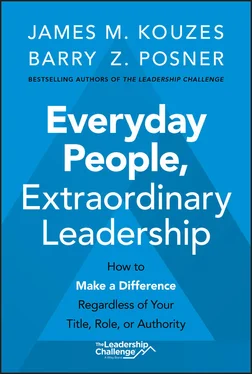Leaders proudly discussed how they had to foster collaboration by building a climate of trust and facilitating relationships . They engage all those who were necessary to make the project work, and develop collaborative relationships with colleagues. They are considerate of the needs and interests of others. They bring people together, creating an atmosphere where people understand they have a shared fate and that they should treat others as they would like to be treated. They make sure that everyone wins.
This experience underscores how the work of leaders is making people feel strong, capable, and committed. Leaders strengthen others by increasing self-determination and developing competence and confidence . People don't stick around for very long or perform at their best if their leader makes them feel weak, dependent, or alienated. People will give their all when you can strengthen their belief that they can do more than they ever thought possible. In fact, it was not unusual for people to indicate that when working with their best leaders, they gave more than 100 percent of themselves to the endeavor because that leader was able to bring out from them more than what they themselves had imagined. When people have confidence in you and your relationship with them is based on trust they are most willing to take risks, make changes, and maintain forward momentum.
Encourage the HeartThe climb to the top of any new and challenging endeavor is arduous and steep, and it is not surprising that people can become exhausted, frustrated, and disenchanted. Leaders indicated in their Personal-Best Leadership Experiences that they had to Encourage the Heart of those with whom they were working to carry on, especially when they might have been tempted to give up. They said things such as: “You have to show people that you care about them as people and how they are capable of doing a lot more than they think,” “Praise and encouragement are the best gifts because people need to have their hard work and efforts acknowledged, to know that they are making a difference,” and “We were generous with compliments and this allowed us to feel good about ourselves, and when you feel good you are more productive.”
Genuine acts of caring, whether exhibited in dramatic gestures or simple actions, uplift people's spirits and keep them motivated. It is part of a leader's job to recognize contributions by showing appreciation for individual excellence . Over the years, we've seen thousands of examples of individual recognition and group celebration, from handwritten thank-you notes to marching bands and biopic video ceremonies. But recognition and celebration aren't about fun and games—though both abound when leaders encourage the hearts of their constituents. Encouraging the heart is also not about orchestrating formal awards ceremonies or throwing parties designed to create some artificial sense of camaraderie. It is about celebrating the values and the victories by creating a spirit of community . Public encouragement is valuable because it's how you visibly reinforce what's important and show appreciation for actions that support the team's values. Whether striving to raise quality standards, recover from disaster, or make a dramatic change of any kind, people must see the benefit of aligning behavior with cherished values. When celebrations and rituals are done with authenticity and from the heart, you build a strong sense of collective identity and community spirit that can carry a group through tough times.
These five leadership practices—Model the Way, Inspire a Shared Vision, Challenge the Process, Enable Others to Act, and Encourage the Heart—do not represent an ideology or theory about leadership so much as they provide an operating system for what it means to be practicing leadership and making a difference. Engaging in any of the behaviors associated with The Five Practices does not necessitate any particular personality or require any specific demographic characteristics or advanced educational degrees. There's a very good chance that you are already leading; you just might not recognize that you are doing it. Or perhaps you don't believe you can exercise leadership and don't see yourself as a leader; in that case, there's a very good chance that what you think you can't do, you won't do.
Another essential lesson we learned when analyzing Personal-Best Leadership Experiences is that leadership is a set of behaviors and actions that are available to everyone. Leadership is not some mystical quality or the private reserve of a special class of charismatic people. It is not a gene or a trait in the DNA of a blessed few. It is not a single personality characteristic or a special innate talent that some people have and others do not. It is not a singular strength, and it is not a gift from the gods.
We repeat: Leadership is a set of behaviors and actions that are available to everyone. Let's check out that claim! For each of the questions below, please answer “yes” or “no.” Have you ever:
Spoken about one or more values that you hold dear?
Set a personal example of what you wanted someone else to do?
Talked excitedly about something that might be possible, even though it didn't exist today?
Asked someone else to go along with you to do something?
Tried to make something work better than it was currently?
Been one of the first people to try something new or different from what you were used to doing?
Listened intently to someone else's point of view, someone you didn't necessary agree with?
Helped someone else learn how to do an assignment or work better?
Said “thank you” to another person for a job done well?
Taken part in a celebration recognizing the accomplishment of a colleague?
These are just some of the actions that leaders take day-in and day-out when at their best, and if you answered “yes” to many or most of the questions above, then congratulations because this means you are already leading . Maybe you are not leading frequently enough, but you are leading. On the other hand, if you answered “no” to most of these questions, we think you'll agree that all of them are actions you could take if you were convinced that doing so would be beneficial, resulting in greater well-being and productivity for yourself and others.
Leadership is in the actions that you take. It emerges from the values that guide your decisions and behavior. It results from the visions you have for yourself and others. It is evident in the changes you initiate and the challenges you accept. It appears in the trust you build and the connections you strengthen. It's about how you lift others up and how you make others feel valued.
Even though we can demonstrate to you that leadership is something you—and others—can do, leadership myths persist. And clearly those myths include believing that leadership comes with a title or position, that it requires a set of direct reports, and that leadership is some genetic quality that is in short supply. Becoming an exemplary leader begins with the belief that everyone is capable of leadership and that you can be a better leader than you are right now because you can learn to improve your skills and abilities. It is also essential that you believe that your actions matter and that leadership makes a difference.
Leadership Makes a Difference
Exemplary leadership makes a significant difference in people's levels of well-being, commitment, and motivation, their work performance, and the success of their organizations. That's the definitive conclusion from analyzing data from over three million respondents around the world using the Leadership Practices Inventory to assess how often people engage in The Five Practices of Exemplary Leadership. 10 Those leaders who most frequently use The Five Practices are considerably more effective across a variety of outcomes than their counterparts who use them less often.
Читать дальше












